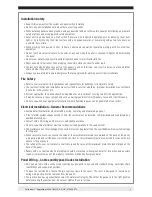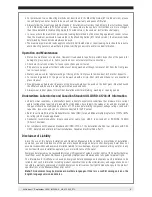
Installation Safety
• Keep children away from the system and panels when installing.
• Do not carry out installation work when there are strong winds.
• When installing panels above ground, avoid any possible falling or other safety hazards by following appropriate
safety practices and using required safety equipment.
• Solar electric panels have no on/off switch. Panels can be rendered inoperative only be removing them from
light, or by fully covering their front surface with an opaque material, or by working with panels face down on
a smooth, flat surface.
• When working with panels in light, follow all applicable regulation regarding working with live electrical
equipment.
• Do not touch electrical terminals or the ends of any wire while the panel is exposed to light or while installing
the panel.
• Do not wear metallic jewelry while performing mechanical or electrical installation.
• Never open electrical connections or unplug connectors while the circuit is under load.
• Contact with electrically active parts of the panels, such as terminals, can result in burns, sparks and lethal
shock whether the panel is connected or disconnected.
• Always use insulated tools and rubber gloves that are approved for working on electrical installations.
Fire Safety
• Refer to your local authority for guidelines and requirements for building or structural fire safety.
• The roof construction and installation may affect the fire safety of a building; improper installation may contribute
to hazards in the event of fire.
• For roof application, the panels should be mounted over a fire resistant covering rated for the application.
• It may be necessary to use components such as earth ground fault circuit breakers, fuses and circuit breakers.
• Do not use panels near equipment or locations where flammable gases can be generated or can collect.
Electrical Installation –General Recommendations
• Avoid all electrical hazards when installing, wiring, operating and maintaining a panel.
• If the total DC system voltage exceeds 100V, the system must be installed, commissioned and maintained by a
qualified professional.
• Contact with a DC voltage 30V or more is potentially hazardous.
• Do not use panels of different electrical or physical configurations in the same system.
• The maximum open circuit voltage of the system must not be greater than the specified maximum system voltage
for the panel.
• When reverse currents can exceed the value of the maximum protective fuse marked on the back of the panel,
a properly rated and certified over-current device (fuse or circuit breaker) must be connected in series with each
panel or string of panels.
• The rating of the over-current device shall not exceed the value of the maximum protective fuse marked on the
back of the panel.
• Panels with a suspected electrical problem should be returned to Evergreen Solar for inspection and possible
repair or replacement as per the warranty conditions provided by Evergreen Solar.
Panel Wiring – Cables and Bypass Diodes Installation
• ES-C panels come with a conduit ready junction box designed to be used with standard wiring, watertight strain
relief fittings and conduit connections.
• To open the junction box, loosen the two captive screws in the cover. The cover is designed to remain open
during wiring and cannot be removed from the panel.
• The junction box has a gasket that ensures the waterproof integrity. Check that the gasket is in the right position
before securing the junction box. Do not over-tighten the cover screws.
2
Valid from 1
st
September 2009 / IMW-ES-C_US_010909_ETL





























